
NOW Articles Written By Members
An Argument for Collecting Half Dollars
Late Night and a Russian Type Set
Old Country Coins: Newfoundland’s Rarest 5-Cent
Milwaukee Medals: Fifth Ward Constable
A look back at a common, but classic commemorative – Wisconsin’s Territorial Centennial
A side-tracked story: Mardi Gras Doubloons
A look back at a collecting specialty – the O.P.A. ration tokens of WWII
Bullion And Coin Tax Exemption – Act Now!
Is There A Twenty Cent Piece We Can Add To A Collection
Capped Bust Half Dollars: A Numismatic Legacy
U.S. Innovation Dollars: Our Most Under-Collected Coin?
My 2023 ANA Summer Seminar Adventure
>> More articles in the Archive
For more NOW Articles Written By Members,
Wisconsin Territorials
COME JOSEPHINE, IN MY WAYBACK MACHINE
by David D. Gladfelter
Every school child in this state knows that before Wisconsin became a state, it was a territory. Less well known is that before formation of the Wisconsin Territory, there was a bank: The Bank of Wisconsin, in Green Bay.
Fortunately for collectors, notes issued by this early bank - Wisconsin's first - are readily available. The 1836-dated note shown here (fig. 1) is not only among the most common of the seven denominations in the set, but to me is also the most interesting because of its central vignette depicting the first Treaty of Prairie du Chien, negotiated and agreed to in September 1825, among representatives of the federal government and some nine native American nations. The engraved vignette is after a colored lithograph drawn from life by James Otto Lewis (1799-1858) who was present at the event. In the background is Fort Crawford with the 24-star American flag flying above it.
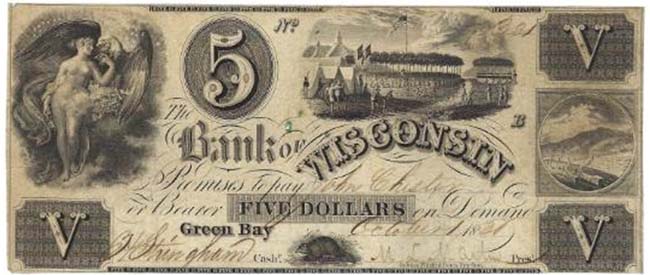
This treaty established boundaries and hunting rights among the Sioux, Ojibwe, Sauk, Fox, Menominee, Iowa, Ho-chunk, Ottawa, and Potawatomi nations, and declared peace among them. Importantly for the settlement of Wisconsin, the treaty and others following also ceded the natives' territorial claims to the federal government, thereby opening the land to settlers. They came rapidly. Forests were cleared. Towns were surveyed. Roads were laid out and improved, some along existing trails. Houses were built. Farms, mines, and businesses were established.
On April 20, 1836, the Wisconsin Territory was formally separated from the Michigan Territory by act of Congress, the separation to take effect as of July 4. The Four Lakes site was chosen for its capital, Madison.
The charter granted to the Bank of Wisconsin by the Michigan Territorial Council in 1835 was recognized by the Wisconsin government, which granted additional bank charters. One was to the Miners Bank of Dubuque, a town that initially was part of the Wisconsin Territory. This bank became an Iowa territorial bank when that territory was split off in 1838. Its Wisconsin notes are rare.
Other Wisconsin territorial banks and business entities included the Farmer's and Mechanic's Bank of Burlington, the Bank of the Fox River Hydraulic Company of De Pere, the trading post of John Jacob Astor in Green Bay (its notes known only as remainders), the Wisconsin Marine and Fire Insurance Co. of Milwaukee, the Mineral Point Bank, the Prairie du Chien Ferry Company, and the Territory of Wisconsin itself. In addition, notes were printed for the first Bank of Milwaukee (which failed to raise capital and never opened) and were fraudulently printed for perpetrators of three nonexistent banks purportedly located in Milwaukee, Mineral Point and Sinipee, mocking the names of genuine banks. Roger H. Durand, in his book Interesting Notes about Territories, lists 67 different bank notes, scrip and fiscal paper items known to have been produced during Wisconsin's territorial period, including the spurious notes. Add to this list the 1839-dated $1.00 note of the Corporation of Mineral Point, illustrated by Chester L. Krause in Wisconsin Obsolete Bank Notes and Scrip.
Unfortunately, the Bank of Wisconsin did not last long. Its charter was revoked during the panic of 1837 when loans it had made to settlers and businesses during the land boom went bad. Its modest capital of $100,000 was exhausted by its creditors' claims. Its president, the distinguished Morgan L. Martin (1805-1887), whose biography is cited in the 1878 Historical Atlas of Wisconsin and reproduced in Krause, went on to a career in politics, law, and the military. A Green Bay elementary school is named in his honor.
None of the territorial banks survived until statehood in 1848. The territorial era was a time of widespread popular distrust of banks.
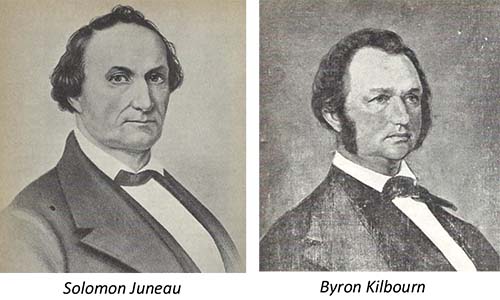
Whether it is common or rare, a collector can't help feeling a bit excited when a numismatic or exonumic item from the territorial era turns up, particularly if it is a new discovery. Such was the case of this $1.00 note of the Town of Milwaukee (fig. 2, following page) dating to 1837 during the height of the rivalry between Solomon Juneau (1793-1856) and Byron Kilbourn (1801-1870) over the development of their respective portions of what would become, in 1846, the city of Milwaukee.
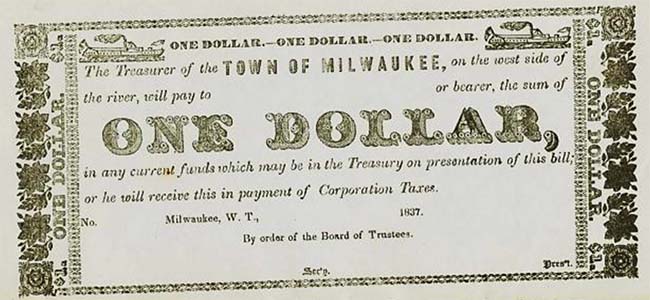
The note is a remainder - only a printed form that has not been signed and issued. The form is fairly sophisticated in design and makes use of several different fonts and sizes of type, as well as decorative elements and small woodcuts of steamboats. There is no printer's imprint. Milwaukee's earliest printer, Daniel Richards, had opened his shop only the year prior, but there were job printers in Chicago who were capable of such work.
Placing this note in its historical context requires a bit of Geography 101. The W. T. on the note's date line stands for Wisconsin Territory, of course, which at the beginning covered the area of the present states of Minnesota, Iowa, and those parts of North and South Dakota lying north and east of the Missouri River, as well as the present state of Wisconsin.
The Town of Milwaukee actually preceded formation of the Wisconsin Territory. The town was created by the Michigan Territorial Legislature on September 6, 1834, and included within its original boundaries what is now southeastern Wisconsin - an area from Madison east to Lake Michigan and from Beaver Dam and West Bend south to the Illinois state line. Included were the present counties of Dodge, Jefferson, Kenosha, Milwaukee, Ozaukee, Racine, Rusk, Walworth, Washington, and Waukesha, as well as parts of Dane and Columbia Counties. Its government had power to levy property taxes and to provide local services such as roads and schools. The first elections were held in 1835.
Almost immediately, parts of the Town of Milwaukee began splitting away. A portion east of the Milwaukee River was surveyed in 1835 by Juneau and Morgan L. Martin and became the self-governing East Side Village.
The County of Milwaukee was created (then including the present Waukesha County) and within it, the Town of Lake in the southern portion and the Town of Milwaukee remaining in the northern portion. Shortly, the separate County of Waukesha was formed. Later in the 19th century, the city of Milwaukee and five townships were carved from the Towns of Lake and Milwaukee.
The lakeside villages of Shorewood, Whitefish Bay, Fox Point and River Hills separated in the first half of the 20th century. The last vestige of the Town of Milwaukee disappeared with incorporation of the City of Glendale in 1950.
The original governing body of the Town of Milwaukee, "on the west side of the river," as shown on the note, (i.e., Kilbourntown) was called a Board of Trustees. Officers of the Board included a president, a secretary, and a treasurer. The obligation clause on the note called for payment to be made on demand if "current funds... may be in the Treasury;" if not, the note was made receivable for payment of taxes. It was thus an early form of what are today called tax anticipation notes. It is not unique. A second example, also a remainder, has now surfaced.
We conclude with an 1846 stock certificate issued by a print shop in "Milwaukie" (below, front and back), a late use of a variant spelling of the newly incorporated city's name. From this shop was published the American Freeman, an anti-slavery newspaper that catered to the views of immigrant settlers of the 1840s. Charles Durkee (1805-1870), president of the association, became a United States congressman and senator in the 1850s and governor of the Utah Territory after that.
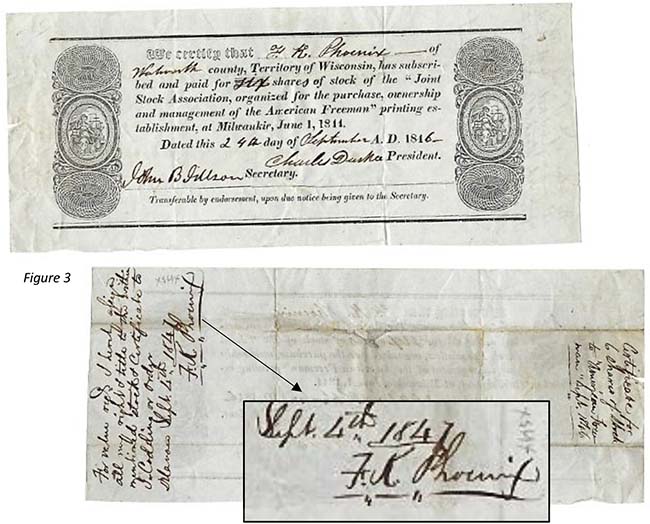
The subscriber, F. K. Phoenix, was a member of the founding family of Delavan. The 1882 History of Walworth County, Wisconsin, published by the Western Historical Company of Chicago, contained this brief but glowing biographical account of him:
"Franklin K. Phoenix, proprietor of the Phoenix Nursery of Delavan, Wis., is the son of Samuel F. and Sarah A. Phoenix; was born in Perry, Genesee Co., now Wyoming Co., N.Y., March 3, 1825. In July 1837, he came to Walworth Co., Wis., with his parents and located on Sec. 15, town of Delavan, in September of that year. He returned East in the spring of 1841, and attended school in his native town one year; returned to Delavan in 1842 and established a nursery, which he carried on until June, 1854, when he moved to Bloomington, Ill., where he engaged in the same business on an extensive scale, having at one time 600 acres under stock, making one of the largest nurseries in the country, if not in the world; annual sale amounted to $200,000. Owing to a succession of unfavorable seasons, he became embarrassed, and was obliged to close out the business in 1877. He remained at Bloomington one year later, then went to the State of New York, where he remained until August 1879, and then returned to Delavan, where he has since resided. On his return to Delavan, he re-established a nursery. He was married, at Darien, Walworth Co., Wis., Dec. 2, 1850, to Mary E. Topping, daughter of Thomas Topping. Mrs. Phoenix was born in Montgomery Co., N.Y. They had seven children ? five sons and two daughters ? Samuel T., A. Melville (died at 18 years of age), Fred S., F. May, Frank, John J., Carrie."
Phoenix, like many who came to Wisconsin during the territorial period, was active in the temperance movement even before attaining adulthood. In 1840 his Delavan Temperance Society unsuccessfully petitioned the Territorial Legislature to make Wisconsin a dry state.
In 1848 Phoenix built a three-story hotel in Delavan for his mother, who owned and operated it. In 1852 he donated 11 1/2 acres of land to build a school for the deaf, became a member of its first board of trustees and its first secretary, and the following year its president.
But he did not take an active role as a newspaper publisher. Barely one year after buying its stock, Phoenix sold it, per signed endorsement. The newspaper ceased publication in 1848.
FOR FURTHER READING:
Theodore A. Anderson, A Century of Banking in Wisconsin (Madison: State Historical Society of Wisconsin, 1954).
H. Russell Austin, The Wisconsin Story: The Building of a Vanguard State (Milwaukee: The Journal Company, 1948).
H. Russell Austin, The Milwaukee Story: The Making of an American City (Milwaukee: The Journal Company, 1946).
William Brandimore, "Early Banking in Wisconsin Territory," N.O.W. News 34(3): 14-16 (Fall 1996).
Opinion of the Supreme Court of Wisconsin in the matter of Durkee vs. Stringham, et al., 8 Wis. 1 (1859). The court held that Henry T. Stringham, cashier of the then-defunct Bank of Wisconsin, did not defraud the plaintiff in a matter involving a business venture of Stringham's separate from the bank. While the bank itself is only tangentially mentioned in the 131-page opinion, many facts of interest are reported, as well as the parallel involvement of two of the bank's directors, James D. Doty and John Chester, in Stringham's separate venture.
Harold Shannon, 75 Happy Years: The Biography of a Bank, in the 1996 history of Associated Bank of Green Bay, pages 17-21. Here the author presents a short history of the short-lived Bank of Wisconsin, with a sketch of the original bank building, no longer standing.
University of Wisconsin-Milwaukee web site, Encyclopedia of Milwaukee, emke.uwm.edu, various entries.
Images of notes and stock certificate are from the author's collection.
Images of Juneau and Kilbourn are from H. Russell Austin, The Milwaukee Story
Illustration of early Juneau home is from the Wisconsin Historical Society
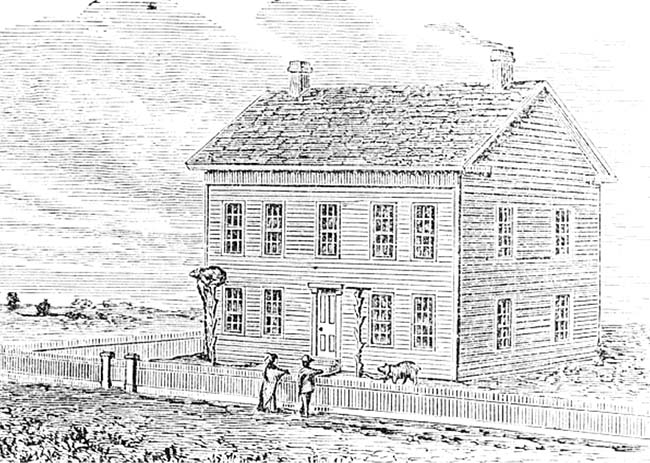
Solomon Juneau home erected in 1835 on the site that is now the Southeast corner of Michigan and Water Streets in Milwaukee. Juneau established trade with native peoples as early as 1818.
Have an interesting numismatic topic you’d like to share with your fellow NOW members?
Send your article to evan.pretzer@protonmail.com today!!!